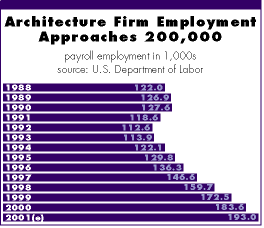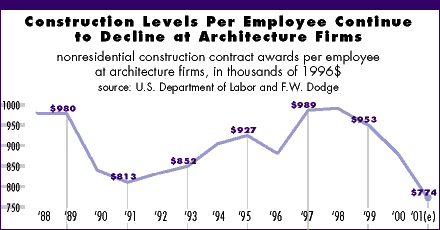
Increase in architects projected at 2% per year this decade, exceeding engineers, interior designers, construction trades

AIA Chief Economist
National construction activity slowed considerably last year. Nonresidential new construction contracts declined an estimated 10% on a space basis, according to data from F.W. Dodge. Residential construction activity remained essentially flat. Still, employment at architecture firms increased by over 5% in 2001, to a level of 193,000. Since bottoming out at 112,600 in 1992, payrolls at architecture firms have increased more than 70% over the past nine years.
 Each
year since 1993, employment growth at architecture firms has outpaced
growth in the broader construction industry. Overall, the expansion in
employment at architecture firms over this period has been nothing short
of phenomenal. For every 100 employees at architecture firms in 1993,
there are over 169 today. In contrast, for every 100 workers employed
in the U.S. construction industry in 1993, there are 147 today. And in
the broader economy, while there has been an unprecedented increase in
business payrolls over this period, for every 100 workers in 1993 there
are fewer than 120 today.
Each
year since 1993, employment growth at architecture firms has outpaced
growth in the broader construction industry. Overall, the expansion in
employment at architecture firms over this period has been nothing short
of phenomenal. For every 100 employees at architecture firms in 1993,
there are over 169 today. In contrast, for every 100 workers employed
in the U.S. construction industry in 1993, there are 147 today. And in
the broader economy, while there has been an unprecedented increase in
business payrolls over this period, for every 100 workers in 1993 there
are fewer than 120 today.

Implications of strong
growth at firms
While the growth in firm employment is encouraging on one hand, on the
other it is troubling. During the depths of the construction recession
in the early 1990s, there was just over $800,000 (in inflation-adjusted
dollars) in nonresidential construction contracts for each employee at
U.S. architecture firms. By the late 1990s, this figure was approaching
$1 million per employee. However, this figure has been declining rapidly
since 1998. As of last year it had dropped to just over $770,000, well
below the levels of the early 1990s recession.
While architects can creatively provide solutions to problems with the built environment, they cannot repeal the laws of mathematics. And if employment at architecture firms is increasing faster than construction activity, then firms need to gain a larger share of each construction dollar spent.

Service expansion
fueling firm growth
There are several reasons why nonresidential construction activity per
architecture firm employee has been declining in recent years. The most
important is that architecture firms, in expanding their staffing during
this construction cycle, have also been expanding the design disciplines
offered through their firms. According to AIA surveys of member firms,
the share of single-discipline architecture firms declined from 73% to
67% between 1996 and 1999. Over this same period, the share of multidiscipline
firms increased from 23% to 29%. As architecture firms increasingly offer
engineering, interior design, landscape architecture, urban design, and
planning services on their projects, the project billings that remain
in-house rise much more rapidly than does overall construction activity.
Related to this change is the potential shifting share of design activity. With additional disciplines on staff, projects may now be handled at architecture firms that previously were managed by interior design firms, engineering firms, or engineering/architecture firms.
Second, in addition to adding other design disciplines, most architecture firms have expanded the range of services that they are offering to clients. As of 1999, 98% of architecture firms offered at least some planning and predesign services; 97% offered expanded design services; 55% offered construction services; 46% offered operation and maintenance services; and 91% offered other design-related services such as ADA compliance or graphic design. Again, the implication of this trend is that architecture firm billings can rise even when construction activity does not.
Third, an increasing share of construction activity is being devoted to rehabilitation activity. Much rehabilitation activity does not show up in the construction figures. However, many rehabilitation projects require as much—if not more—design involvement as does new construction.
While there may be many solid business reasons for the growth in employment at architecture firms, there also may be reasons for concern over this trend. In spite of all the explanations for additional activity at firms that is not proportional to the change in construction activity, it may also be the case that firms are becoming overstaffed. Many firms were unable to fill open positions over the past several years due to a shortage of qualified applicants and relied on overtime from existing staff to meet project deadlines. Now that there is less competition for qualified applicants, firms may be filling these positions. With conditions having eased a bit, some firms may not have adjusted their staffing levels to the new realities of project workloads.
 Architect
positions projected to increase
Architect
positions projected to increase
Despite dramatic growth in architecture firm staffing in recent years,
the U.S. Department of Labor expects the number of practicing architects
to increase by about 2% per year over the coming decade, from 102,000
in 2000 to a projected 121,000 in 2010. This projected increase is in
excess of expectations for most other design professionals. Interior designers
are expected to increase at a slightly lower rate—17.4% over the
decade, while mechanical and civil engineers at 10–13%. Landscape
architects and environmental engineers are expected to grow at faster
rates than architects.
Copyright 2002 The American Institute of Architects. All rights reserved.
![]()
|
|
|